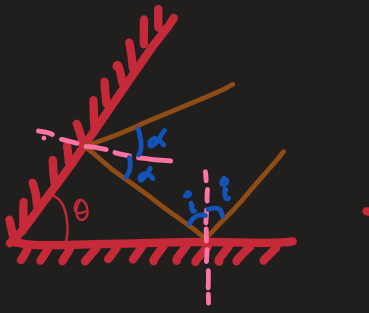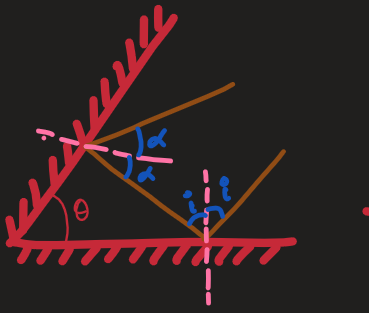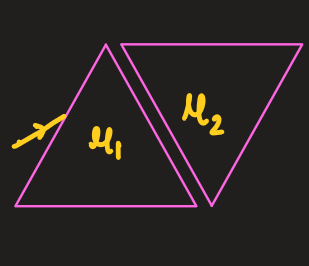ray optics
1/43
Earn XP
Description and Tags
Name | Mastery | Learn | Test | Matching | Spaced |
|---|
No study sessions yet.
44 Terms

deviation if θ>i
δ= 360-2θ
height of the mirror required to see the full image of the man of height h
h/2

deviation if θ=i
no deviation
no of images formed when two plain mirrors are placed at an angle θ(even)
(360/θ)-1
no of images formed when two plain mirrors are placed at an angle θ(odd, symmetrical)
(360/θ)-1
no of images formed when two plain mirrors are placed at an angle θ(odd, unsymmetric)
(360/θ)
mirror formula
1/v + 1/u = 1/f
newton’s formula of finding focus(f)
√(xi xo)
snell’s law
μ1sinθ1= μ2sinθ2
magnification in mirror (use f and u)
f/(f-u)
magnification in mirror (use f and v)
(f-v)/f
lateral deviation of glass slab
{ t sin(i - r) } / cos r
lateral shift in small angle
t x i [1-(1/μ) ]
longitudnal shift
t [ 1-(1/μ) ]
magnification of mirror( use u and v)
-(v/u)
curved refraction
(μ2/v) - (μ1/u) = (_μ2-μ1)/R
lens maker formula
1/f = [ ( μlens / μmedium ) - 1 ] [ (1/R1) - (1/R2) ]
focus for planoconcave lens
-R/(μ-1)
focus for planoconvex lens
R/(μ-1)
focus for biconcave lens
-R/(2(μ-1))
focus for biconvex lens
R/(2(μ-1))
lens formula
1/v - 1/u = 1/f
magnification of lens( use f and u)
f/(f+u)
μ when min deviation is given
sin[(δmin+ A)/2] / sin[ (A/2)]
r1+r2=
angle of prism
δ in prism
i+e-A
dispersion angle (θ)
δb-δr = (μb- μr)A
dispersive power ()
(δb-δr)/(δavg-1) = (μb- μr)/(μavg-1)
no deviation formula
(μy1-1)A1 = (μy2-1)A2
no dispersion formula
(μb1- μr1)A1 = (μb2- μr2)A2
magnification of simple microscope (relax eye)
D/f
magnification of simple microscope (constrain eye)
1+(D/f)
magnification of compound microscope (relax eye)
(vo/uo)(D/fe)
magnification of compound microscope (constrain eye)
(vo/uo)[1+(D/fe)]
magnification of astronomical telescope (relax eye)
fo/fe
magnification of astronomical telescope (constrain eye)
(fo/fe)(1+(fe/D))
length of telescope (relax eye)
fo+fe
length of telescope (constrain eye)
fo+(feD/fe+D)
magnification of terrestrial telescope
fo/fe
magnification of Cassegrain telescope
fo/fe= R/(2fe)
length of terrestrial telescope
fo+fe+4ferrecting lens

deviation in this case is
δ=2i

whats the case
no dispersion

whats the case
no deviation